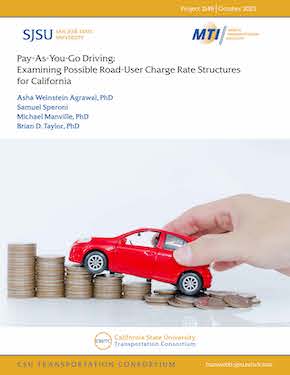- 408-924-7560
- mineta-institute@sjsu.edu
- Donate
Pay-As-You-Go Driving: Examining Possible Road-User Charge Rate Structures for California
This report lays out principles to help California policymakers identify an optimal rate structure for a road-user charge (RUC). The rate structure is different from the rate itself. The rate is the price a driver pays, while the structure is the set of principles that govern how that price is set. We drew on existing research on rate setting in transportation, public utilities, and behavioral economics to develop a set of conceptual principles that can be used to evaluate rate structures, and then applied these principles to a set of mileage fee rate structure options. One key finding is that transportation system users already pay for driving using a wide array of rate structures, including some that charge rate structured based on vehicle characteristics, user characteristics, and time or location of driving. We also conclude that the principal advantage of RUCs is not their ability to raise revenue but rather to variably allocate charges among various types of users and travelers. To obtain those benefits, policymakers need to proactively design rate structures to advance important state policy goals and/or improve administrative and political feasibility.
ASHA WEINSTEIN AGRAWAL, PHD
Dr. Agrawal is Director of the MTI National Transportation Finance Center and also Professor of Urban and Regional Planning at San José State University. Her research and teaching interests in transportation policy and planning include transportation finance, bicycle and pedestrian planning, travel survey methods, and transportation history.
SAMUEL SPERONI
Samuel Speroni is a doctoral student in the Department of Urban Planning at UCLA, a researcher at the Institute of Transportation Studies at UCLA, and a researcher at the Mineta Transportation Institute. He researches travel behavior, transportation finance, and school transportation, with a special focus on investigating the equity implications within each of those areas. He earned his master’s degree in Urban and Regional Planning from UCLA and a bachelor’s degree with honors in Urban Studies from Brown University.
BRIAN D. TAYLOR, PHD, FAICP
Brian Taylor is Professor of Urban Planning and Public Policy, and Director of the Institute of Transportation Studies at UCLA. He studies and teaches about travel behavior, public transit, and transportation finance. His most recent work on the latter of these is his co-authored book, The Drive for Dollars: How Fiscal Politics Shaped Urban Freeways and Transformed American Cities, published in 2023 by Oxford University Press.
MICHAEL MANVILLE, PHD
Michael Manville is a Professor and Chair of Urban Planning at the UCLA Luskin School of Public Affairs. Both his research and teaching focus on the relationships between transportation and land use, and on local public finance. Dr. Manville has an MA and PhD in Urban Planning, both from UCLA. Prior to joining Luskin as a faculty member, he was Assistant Professor of City and Regional Planning at Cornell University.
-
Contact Us
San José State University One Washington Square, San Jose, CA 95192 Phone: 408-924-7560 Email: mineta-institute@sjsu.edu






